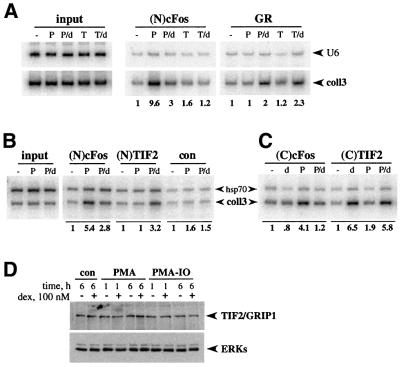Fig. 3. GR and TIF2 are recruited to col3A in a dex-dependent, PMA-independent manner. (A) GR recruitment to col3A. U2OS.G cells were untreated (–) or treated with PMA (P), PMA+dex (P/d), TNF (T) or TNF+dex (T/d) for 1 h and chromatin immunoprecipitations were performed with (N)cFos and GR polyclonal antibodies. coll3 and control U6 sequences were amplified, 32P incorporation into coll3 product was quantified and normalized to the untreated sample. (B) TIF2 occupancy of col3A. U2OS.G cells were treated as in Figure 1B and chromatin immunoprecipitations were performed with (N)cFos, (N)TIF2 polyclonal antibodies or normal rabbit serum (con). coll3 and hsp70 sequences were co-amplified, 32P incorporation into coll3 product was quantified and normalized to the untreated sample in each case. (C) AP-1 activation with PMA is not required for TIF2 recruitment. U2OS.G cells were untreated (–) or treated with dex (d), PMA (P) or PMA+dex (P/d) for 1 h and chromatin immunoprecipitations were performed with (C)cFos polyclonal and (C)TIF2 monoclonal antibodies. Quantitation was performed as described in (B). (D) TIF2 protein expression is unaffected by PMA or dexamethasone. U2OS.G cells were untreated (con) or treated with PMA or PMA/IO, in the presence or absence of dex, for 1 or 6 h, as indicated, and TIF2 expression in whole cell extracts was examined by immunoblotting with anti-TIF2 polyclonal antibodies (upper panel). Equal loading into each lane was verified by blotting with anti-ERK polyclonal antibodies (lower panel).

An official website of the United States government
Here's how you know
Official websites use .gov
A
.gov website belongs to an official
government organization in the United States.
Secure .gov websites use HTTPS
A lock (
) or https:// means you've safely
connected to the .gov website. Share sensitive
information only on official, secure websites.
